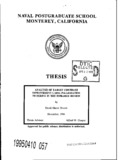Experimental study of contrast utilizing a vidicon.

Download
Author
Havel, Richard William
Date
1980-06Advisor
Crittenden, E.C. Jr.
Second Reader
Cooper, A.W.
Metadata
Show full item recordAbstract
A commercial multi-purpose closed circuit television
camera system with a vidicon image tube was studied to
determine its capability for measurement of contrast and
visibility. A single line of the scan from the camera
video output was extracted and examined with an oscilloscope.
A derivation of system response was made and a comparison
performed with laboratory data. Calibration of the field
of view, for one particular television pick-up tube, revealed
nonuniformities making resolution of 2 percent contrast
difficult. Useful resolution results are expected with
improvement of the pick-up tube or with employment of digital
processing techniques.
Rights
This publication is a work of the U.S. Government as defined in Title 17, United States Code, Section 101. Copyright protection is not available for this work in the United States.Collections
Related items
Showing items related by title, author, creator and subject.
-
Diesel Submarine Support to SOF
Ferrer, Geraldo; Veronneau, Simon (Monterey, California: Naval Postgraduate SchoolMonterey, California. Naval Postgraduate School, 2019-12); NPS-19-N062-AGiven the limited availability of submarines to support SOF and the potential to save billions of dollars, as well as improve a capability through quiet, shallow-water capable submarines, a review of potential diesel-electric ... -
Diesel Submarine Support to SOF
Ferrer, Geraldo; Veronneau, Simon (Monterey, California: Naval Postgraduate SchoolMonterey, California. Naval Postgraduate School, 2019-12); NPS-19-N062-AGiven the limited availability of submarines to support SOF and the potential to save billions of dollars, as well as improve a capability through quiet, shallow-water capable submarines, a review of potential diesel-electric ... -
Analysis of target contrast improvement using polarization filtering in the infrared region
Moretz, David Gavin (Monterey, California. Naval Postgraduate School, 1994-12);Computer analysis with IDL was performed on polarized infrared image data obtained during the MAPTIP coastal experiment. Analysis of contrast enhancement of the oceanographic ship Hr. Ms. Tydeman and a Lynx helicopter using ...


 experimentalstud00have.pdf (3.835Mb)
experimentalstud00have.pdf (3.835Mb)

